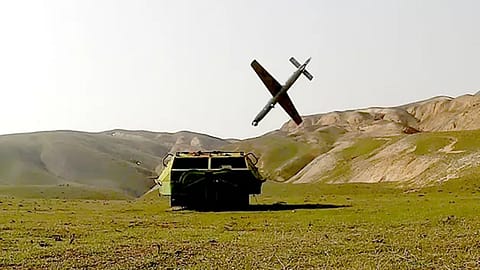Precision from the skies: India’s drone moment is here as UAVs prove their mettle on the front line
India's anti-drone systems neutralised more than 300 drone attacks from Pakistan on Thursday.

India's military drones demonstrated striking precision and effectiveness in a first-of-its-kind real combat test within two days of the ongoing India-Pakistan conflict. On May 7, India used missiles and drones to hit nine targets in Pakistan from India's territory to precision, while a day later, its anti-drone systems neutralised more than 300 drone attacks from the neighbouring nation.
So far, India’s defence drones have been monitoring the country’s border areas, especially the ones we share with Pakistan and China, for reconnaissance, surveillance and communications relay missions, imaging, damage assessment, and payload delivery.
Though drones were being used globally in warfare for two decades, the first major reported drone battle was in April 2008, when Russia downed a Georgian Hermes 450, an Unmanned Aerial System (UAS) designed by Israeli defence company Elbit. Drones gained the world's attention when Ukrainian soldiers used Turkish-made Bayraktar TB2 suicide drones, that are the size of a small plane and armed with laser-guided bombs, to sink the Russian warship Moskva in the Black Sea in April 2022.
Russia retaliated with a battery of Shahed drones and FPV (First Person View) drones, and destroyed US-supplied Abrams tanks, one of the most advanced tanks in the world. That was the moment the world realised that drones and new technologies were going to be a major weapon in future wars. That’s when questions arose on India’s drone defence capabilities.
DRDO and drones
India’s efforts to make indigenous military drones started way back in 1990 when the Defence Research & Development Organisation (DRDO) attempted to build 'Nishant' Unmanned Aerial Vehicles (UAVs). While developing their own drones, the Indian defence services were importing drones for their war strategies. Over the years, India imported many units of Heron I, Searcher Mk II, and Harop loitering munitions from Israel, and these were deployed at strategic defence bases.
Reportedly, Harops were used by India in its attacks on Lahore on Thursday. However, the Indian military is yet to confirm the attacks.
Recommended Stories
Data from Stockholm International Peace Research Institute (SIPRI), an independent global conflict-research institute, says India accounted for the largest share (22.5%) of the world's UAV imports between 1985 and 2014, followed by the UK and France. Almost all of those were from Israel.
In June 2021, in a $200-million deal, India leased four Israeli-made Heron drones, having Automatic Taxi-Take off and Landing (ATOL) systems, ultra-long-range surveillance cameras, and other state-of-the-art gadgets, for surveillance in the Ladakh region, bordering China. DRDO and related institutions like Aeronautical Development Establishment (ADE) laboratory were developing indigenous drone projects like Abhyas, Ghatak, Rustom- 1, TAPAS, Imperial Eagle, Kapothaka, Lakshya, Nishant, Golden Hawk, Pushpak, and Slybird. Over the years, some of them went into commercial production.
Two major PPP projects were Netra, developed by Mumbai-based IdeaForge and the Research and Development Establishment (R&DE), and the HAL CATS warrior drone programme by Newspace R&D and HAL. HAL CATS combines a manned fighter aircraft with a set of swarming UAVs and Unmanned Combat Aerial Vehicles (UCAVs), enabling deep penetration strikes and high-altitude surveillance.
In July 2021, the DRDO developed an anti-drone system capable of counterattacks, including detection, Soft Kill (for jamming the communication links of attacking drone) and Hard Kill (laser-based hard kill to destroy the attacking drone). This indigenous DRDO counter-drone technology was transferred to BEL and other companies.
(INR CR)
Further, the DRDO has developed an Autonomous Flying Wing Technology Demonstrator (AFTD), a high-speed UAV capable of landing autonomously, without relying on ground-based radar, infrastructure, or a pilot. It made its maiden flight in July 2022. The IAF is also developing large, stealthy UCAVs like the Ghatak.
Another ongoing project is Archer-NG, an advanced MALE (Medium Altitude Long Endurance) UAV under development. In October last year, India and the US concluded a $3.5-billion deal for the procurement of 31 MQ-9B armed High Altitude Long Endurance (HALE) Remotely Piloted Aircraft Systems (RPAS) manufactured by General Atomics through an inter-governmental agreement.
Private players
Unconfirmed reports say India used SkyStriker suicide drones to hit terror targets in Pakistan during Operation Sindoor. Bengaluru-headquartered Alpha Design Technologies, which was acquired by Adani Defence Systems and Technologies in 2018, makes SkyStriker in partnership with Israel’s Elbit Systems. The Adani Elbit UAV Complex in Hyderabad, which took off in the same year, was the first private UAV manufacturing facility in India and the first facility of Elbit outside Israel to manufacture the Hermes 900 UAVs.
There are many frontline defence drones like Alpha. Anti-drone makers also emerged in recent years. Apart from the public sector firms—HAL, BEL, and Bharat Dynamics—private players in military drone-making include leaders like IdeaForge, Tata Advanced Systems, Adani Defence Systems and Technologies, Paras Defence & Aerospace, Zen Technologies, Sagar Defence, Rattan India, and Garuda Aerospace. JSW UAV Ltd and Shield AI, a leading U.S defence technology company, are investing ₹800 crore in Telangana to make Shield AI’s 'V-BAT,' an Unmanned Aerial System (UAS).
The Indian military drone market generated revenues of $1,527.1 million in 2024 and is expected to reach $4,082.1 million by 2030. It is expected to grow at a CAGR of 17.9% from 2025 to 2030, according to a Grand View Research report.
There were constant efforts from the defence forces to promote the manufacturing of drones to meet their requirement by private players. In August 2022, the Army Design Bureau (ADB) signed an MoU with the Drone Federation of India to collaboratively work towards promoting research, development, testing and manufacturing of drones, counter-drone and associated technologies that can assist the Indian Army in its operations.
The Defence Ministry launched schemes like IDEX for domestic innovation and development of latest technologies. ADITI scheme, aimed to support critical and strategic technologies such as satellite communication, advanced cyber technology, autonomous weapons, semiconductors, artificial intelligence, quantum technology, nuclear technologies, and underwater surveillance, helped in the creation of many start-ups involved in domestic drone and anti-drone systems development.



